Adapting to the Agricultural Labor Market Shaped by Robotization
Abstract
1. Introduction
2. Materials and Methods
2.1. Reviewed Occupations
2.2. Occupation Mapping and Susceptibility to Robotization Rating
- The “green zone”, which denotes a very low potential to robotization, ;
- The “yellow zone”, which represents a low to medium potential to robotization, ,;
- The “red zone”, which signifies a very high potential to robotization, .
2.3. Investigation of the Most Required Qualifications to Cope with Robotization
- Knowledge: related to knowledge of principles and methods of different disciplines, such as mathematics, chemistry, and management;
- Skills: contains a variety of skills, including, indicatively, critical thinking, identifying the reasons behind operational errors, and system analysis;
- Work styles: This set includes several personal characteristics, such as stress tolerance, leadership, and concern for others.
3. Results
3.1. Occupation Mapping in Terms of Their Cognitive/Manual and Routine/Non-Routine Nature and Susceptibility Rate to Robotization
3.2. Comparison of the Present Results with Those of Marinoudi et al. [29]
3.3. Investigation of Key Qualifications towards Adapting to the Ongoing Labor Market Changes in Agriculture
3.3.1. Knowledge
3.3.2. Skills
3.3.3. Work Styles
4. Discussion and Conclusions
Author Contributions
Funding
Institutional Review Board Statement
Data Availability Statement
Conflicts of Interest
References
- Amankwah-Amoah, J.; Khan, Z.; Wood, G.; Knight, G. COVID-19 and digitalization. J. Bus. Res. 2021, 136, 602–611. [Google Scholar] [CrossRef] [PubMed]
- Bochtis, D.; Benos, L.; Lampridi, M.; Marinoudi, V.; Pearson, S.; Sørensen, C.G. Agricultural workforce crisis in light of the COVID-19 pandemic. Sustainability 2020, 12, 8212. [Google Scholar] [CrossRef]
- Santos, G.; Sá, J.C.; Félix, M.J.; Barreto, L.; Carvalho, F.; Doiro, M.; Zgodavová, K.; Stefanović, M. New Needed Quality Management Skills for Quality Managers 4.0. Sustainability 2021, 13, 6149. [Google Scholar] [CrossRef]
- Ciarli, T.; Kenney, M.; Massini, S.; Piscitello, L. Digital technologies, innovation, and skills: Emerging trajectories and challenges. Res. Policy 2021, 50, 104289. [Google Scholar] [CrossRef]
- Almeida, F.; Duarte Santos, J.; Augusto Monteiro, J. The Challenges and Opportunities in the Digitalization of Companies in a Post-COVID-19 World. IEEE Eng. Manag. Rev. 2020, 48, 97–103. [Google Scholar] [CrossRef]
- Frey, C.B.; Osborne, M.A. The future of employment: How susceptible are jobs to computerisation? Technol. Forecast. Soc. Chang. 2017, 114, 254–280. [Google Scholar] [CrossRef]
- Arntz, M.; Gregory, T.; Zierahn, U. The Risk of Automation for Jobs in OECD Countries; OECD: Paris, France, 2016. [Google Scholar] [CrossRef]
- Heyman, F. Job polarization, job tasks and the role of firms. Econ. Lett. 2016, 145, 246–251. [Google Scholar] [CrossRef]
- Döhring, B.; Hristov, A.; Maier, C.; Roeger, W.; Thum-Thysen, A. COVID-19 acceleration in digitalisation, aggregate productivity growth and the functional income distribution. Int. Econ. Econ. Policy 2021, 18, 571–604. [Google Scholar] [CrossRef]
- Watson, G.P.; Kistler, L.D.; Graham, B.A.; Sinclair, R.R. Looking at the Gig Picture: Defining Gig Work and Explaining Profile Differences in Gig Workers’ Job Demands and Resources. Group Organ. Manag. 2021, 46, 327–361. [Google Scholar] [CrossRef]
- Lagorio, A.; Cimini, C.; Romero, D. A Reflective Framework for Understanding Workforce Evolutionary Pathways in Industry 5.0. In Advances in Production Management Systems. Production Management Systems for Responsible Manufacturing, Service, and Logistics Futures, Proceedings of the IFIP WG 5.7 International Conference, APMS 2023, Trondheim, Norway, 17–21 September 2023; FIP Advances in Information and Communication Technology; Springer: Cham, Switzerland, 2023; Volume 689, pp. 501–512. [Google Scholar]
- Li, L. Reskilling and Upskilling the Future-ready Workforce for Industry 4.0 and Beyond. Inf. Syst. Front. 2022; online ahead of print. [Google Scholar] [CrossRef]
- Sørensen, L.B.; Germundsson, L.B.; Hansen, S.R.; Rojas, C.; Kristensen, N.H. What Skills Do Agricultural Professionals Need in the Transition towards a Sustainable Agriculture? A Qualitative Literature Review. Sustainability 2021, 13, 13556. [Google Scholar] [CrossRef]
- Danner, D.; Clemens, L.; Spengler, M. Editorial: Do We Need Socio-Emotional Skills? Front. Psychol. 2021, 12, 723470. [Google Scholar] [CrossRef] [PubMed]
- World Bank World Development Report 2016: Digital Dividends. Available online: https://www.worldbank.org/en/publication/wdr2016 (accessed on 7 July 2022).
- Benos, L.; Sørensen, C.G.; Bochtis, D. Field Deployment of Robotic Systems for Agriculture in Light of Key Safety, Labor, Ethics and Legislation Issues. Curr. Robot. Rep. 2022, 3, 49–56. [Google Scholar] [CrossRef]
- Benos, L.; Moysiadis, V.; Kateris, D.; Tagarakis, A.C.; Busato, P.; Pearson, S.; Bochtis, D. Human-Robot Interaction in Agriculture: A Systematic Review. Sensors 2023, 23, 6776. [Google Scholar] [CrossRef]
- Benos, L.; Bechar, A.; Bochtis, D. Safety and ergonomics in human-robot interactive agricultural operations. Biosyst. Eng. 2020, 200, 55–72. [Google Scholar] [CrossRef]
- Charatsari, C.; Lioutas, E.D. Is current agronomy ready to promote sustainable agriculture? Identifying key skills and competencies needed. Int. J. Sustain. Dev. World Ecol. 2019, 26, 232–241. [Google Scholar] [CrossRef]
- Migliorini, P.; Lieblein, G. Facilitating Transformation and Competence Development in Sustainable Agriculture University Education: An Experiential and Action Oriented Approach. Sustainability 2016, 8, 1243. [Google Scholar] [CrossRef]
- Šūmane, S.; Kunda, I.; Knickel, K.; Strauss, A.; Tisenkopfs, T.; Rios, I.d.I.; Rivera, M.; Chebach, T.; Ashkenazy, A. Local and farmers’ knowledge matters! How integrating informal and formal knowledge enhances sustainable and resilient agriculture. J. Rural Stud. 2018, 59, 232–241. [Google Scholar] [CrossRef]
- Maïga, W.H.E.; Porgo, M.; Zahonogo, P.; Amegnaglo, C.J.; Coulibaly, D.A.; Flynn, J.; Seogo, W.; Traoré, S.; Kelly, J.A.; Chimwaza, G. A systematic review of employment outcomes from youth skills training programmes in agriculture in low- and middle-income countries. Nat. Food 2020, 1, 605–619. [Google Scholar] [CrossRef] [PubMed]
- Blickenstaff, S.M.; Wolf, K.J.; Falk, J.M.; Foltz, J.C. College of Agriculture Faculty Perceptions of Student Skills, Faculty Competence in Teaching Areas and Barriers to Improving Teaching. NACTA J. 2015, 59, 219–226. [Google Scholar]
- Cerutti, A.; Padovan, D.; Bruun, S.; Donno, D.; Beccaro, G. On the Use of Life Cycle Assessment to Improve Agronomists’ Knowledge and Skills toward Sustainable Agricultural Systems. Vis. Sustain. 2017, 7, 38–53. [Google Scholar] [CrossRef]
- Tagarakis, A.C.; Benos, L.; Kyriakarakos, G.; Pearson, S.; Sørensen, C.G.; Bochtis, D. Digital Twins in Agriculture and Forestry: A Review. Sensors 2024, 24, 3117. [Google Scholar] [CrossRef] [PubMed]
- Francis, C.A.; Jensen, E.S.; Lieblein, G.; Breland, T.A. Agroecologist Education for Sustainable Development of Farming and Food Systems. Agron. J. 2017, 109, 23–32. [Google Scholar] [CrossRef]
- Cecchini, M.; Bedini, R.; Mosetti, D.; Marino, S.; Stasi, S. Safety Knowledge and Changing Behavior in Agricultural Workers: An Assessment Model Applied in Central Italy. Saf. Health Work 2018, 9, 164–171. [Google Scholar] [CrossRef]
- Laforge, J.M.L.; McLachlan, S.M. Learning communities and new farmer knowledge in Canada. Geoforum 2018, 96, 256–267. [Google Scholar] [CrossRef]
- Marinoudi, V.; Lampridi, M.; Kateris, D.; Pearson, S.; Sørensen, C.G.; Bochtis, D. The Future of Agricultural Jobs in View of Robotization. Sustainability 2021, 13, 12109. [Google Scholar] [CrossRef]
- O*NET OnLine. Available online: https://www.onetonline.org/ (accessed on 13 March 2024).
- O*NET O*NET-SOC Resource Center. Available online: https://www.onetcenter.org/ (accessed on 13 March 2024).
- Marinoudi, V.; Sørensen, C.G.; Pearson, S.; Bochtis, D. Robotics and labour in agriculture. A context consideration. Biosyst. Eng. 2019, 184, 111–121. [Google Scholar] [CrossRef]
- Moencks, M.; Roth, E.; Bohné, T.; Romero, D.; Stahre, J. Augmented Workforce Canvas: A management tool for guiding human-centric, value-driven human-technology integration in industry. Comput. Ind. Eng. 2022, 163, 107803. [Google Scholar] [CrossRef]
- Hamza, A.; Riaz, F.; Abid, S.; Raza, U.; Holderbaum, W.; Chowdhry, B.S. A Comprehensive Study of the Role of Self-Driving Vehicles in Agriculture: A Review. In Proceedings of the 2023 7th International Multi-Topic ICT Conference (IMTIC), Jamshoro, Pakistan, 10–12 May 2023; pp. 1–7. [Google Scholar]
- Kootstra, G.; Wang, X.; Blok, P.M.; Hemming, J.; van Henten, E. Selective Harvesting Robotics: Current Research, Trends, and Future Directions. Curr. Robot. Rep. 2021, 2, 95–104. [Google Scholar] [CrossRef]
- Vallejo-Gómez, D.; Osorio, M.; Hincapié, C.A. Smart Irrigation Systems in Agriculture: A Systematic Review. Agronomy 2023, 13, 342. [Google Scholar] [CrossRef]
- Ju, C.; Kim, J.; Seol, J.; Son, H. Il A review on multirobot systems in agriculture. Comput. Electron. Agric. 2022, 202, 107336. [Google Scholar] [CrossRef]
- Bigliardi, B.; Bottani, E.; Casella, G.; Filippelli, S.; Petroni, A.; Pini, B.; Gianatti, E. Industry 4.0 in the agrifood supply chain: A review. Procedia Comput. Sci. 2023, 217, 1755–1764. [Google Scholar] [CrossRef]
- Cravero, A.; Pardo, S.; Sepúlveda, S.; Muñoz, L. Challenges to Use Machine Learning in Agricultural Big Data: A Systematic Literature Review. Agronomy 2022, 12, 748. [Google Scholar] [CrossRef]
- Bechar, A.; Vigneault, C. Agricultural robots for field operations: Concepts and components. Biosyst. Eng. 2016, 149, 94–111. [Google Scholar] [CrossRef]
- Eloundou, T.; Manning, S.; Mishkin, P.; Rock, D. GPTs are GPTs: An Early Look at the Labor Market Impact Potential of Large Language Models 2023. arXiv 2023, arXiv:2303.10130. [Google Scholar]
- Filippi, E.; Bannò, M.; Trento, S. Automation technologies and their impact on employment: A review, synthesis and future research agenda. Technol. Forecast. Soc. Chang. 2023, 191, 122448. [Google Scholar] [CrossRef]
- Afonso, Ó.; Forte, R. Routine and non-routine sectors, tasks automation and wage polarization. Appl. Econ. 2023, 1–24. [Google Scholar] [CrossRef]
- Villanthenkodath, M.A.; Pal, S.; Mahalik, M.K. Income Inequality in Globalization Context: Evidence from Global Data. J. Knowl. Econ. 2024, 15, 3872–3902. [Google Scholar] [CrossRef]
- Thornhill-Miller, B.; Camarda, A.; Mercier, M.; Burkhardt, J.-M.; Morisseau, T.; Bourgeois-Bougrine, S.; Vinchon, F.; El Hayek, S.; Augereau-Landais, M.; Mourey, F.; et al. Creativity, Critical Thinking, Communication, and Collaboration: Assessment, Certification, and Promotion of 21st Century Skills for the Future of Work and Education. J. Intell. 2023, 11, 54. [Google Scholar] [CrossRef]
- Carlisle, L.; de Wit, M.; DeLonge, M.S.; Iles, A.; Calo, A.; Getz, C.; Ory, J.; Munden-Dixon, K.; Galt, R.; Melone, B.; et al. Transitioning to sustainable agriculture requires growing and sustaining an ecologically skilled workforce. Front. Sustain. Food Syst. 2019, 3, 96. [Google Scholar] [CrossRef]
- Hackfort, S. Patterns of Inequalities in Digital Agriculture: A Systematic Literature Review. Sustainability 2021, 13, 12345. [Google Scholar] [CrossRef]
- Bardak, U. Global trends shaping labour markets and the demand for labour in the world: An overview. In Changing Skills for a Changing World; Understanding Skills Demand in EU Neighbouring Countries; European Training Foundation: Torino, Italy, 2021; ISBN 978-92-9157-729-3. [Google Scholar]
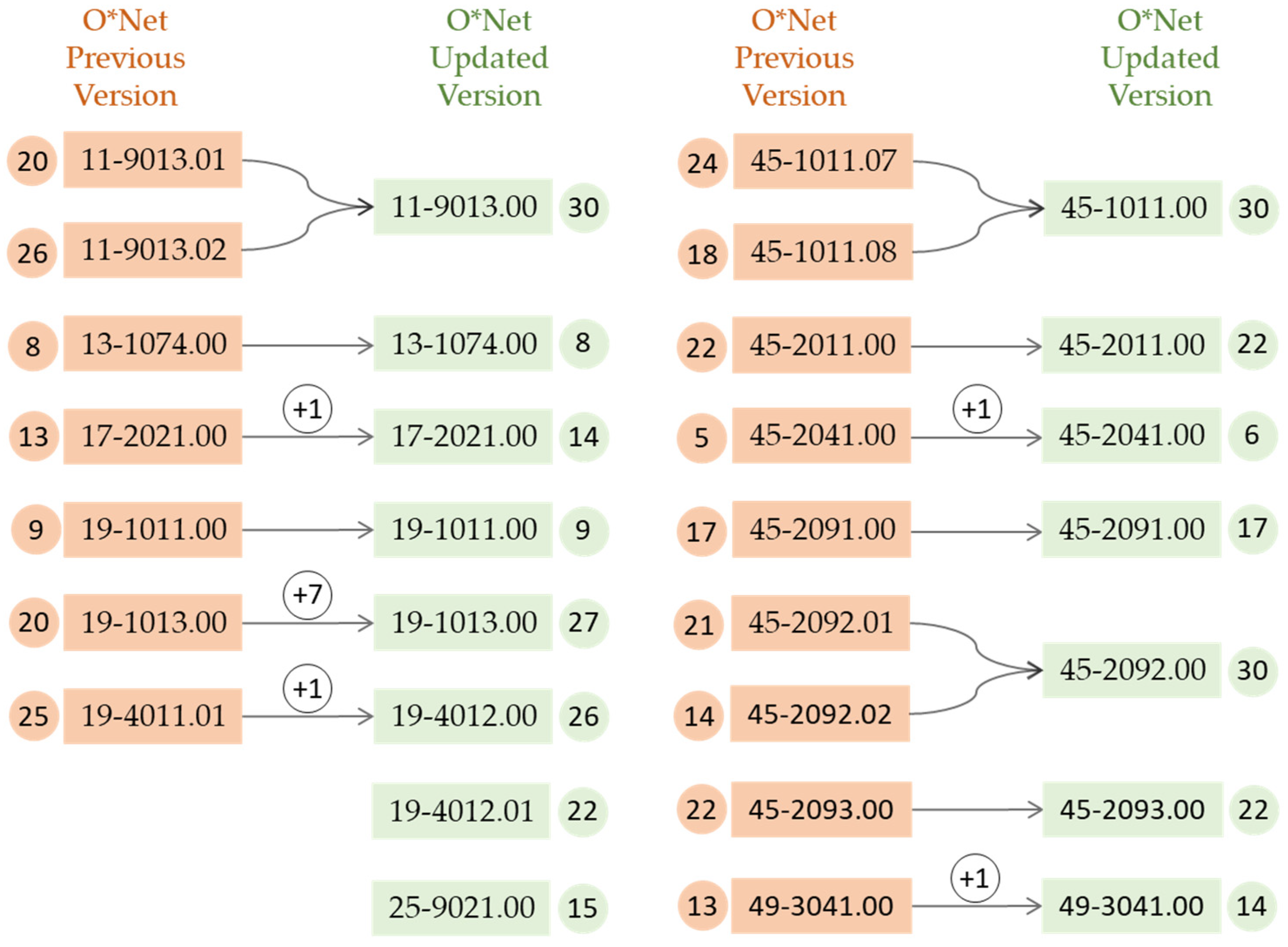
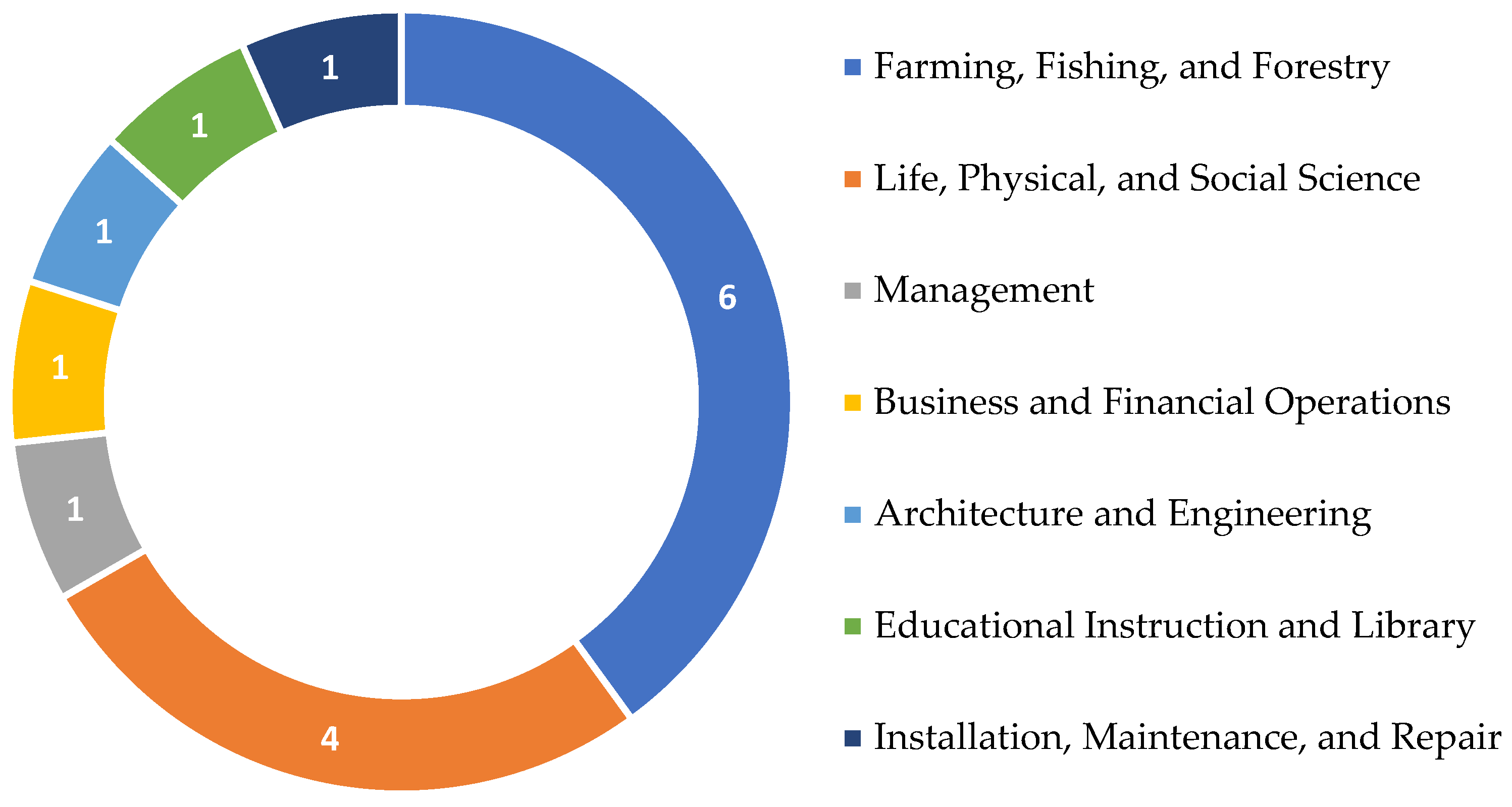
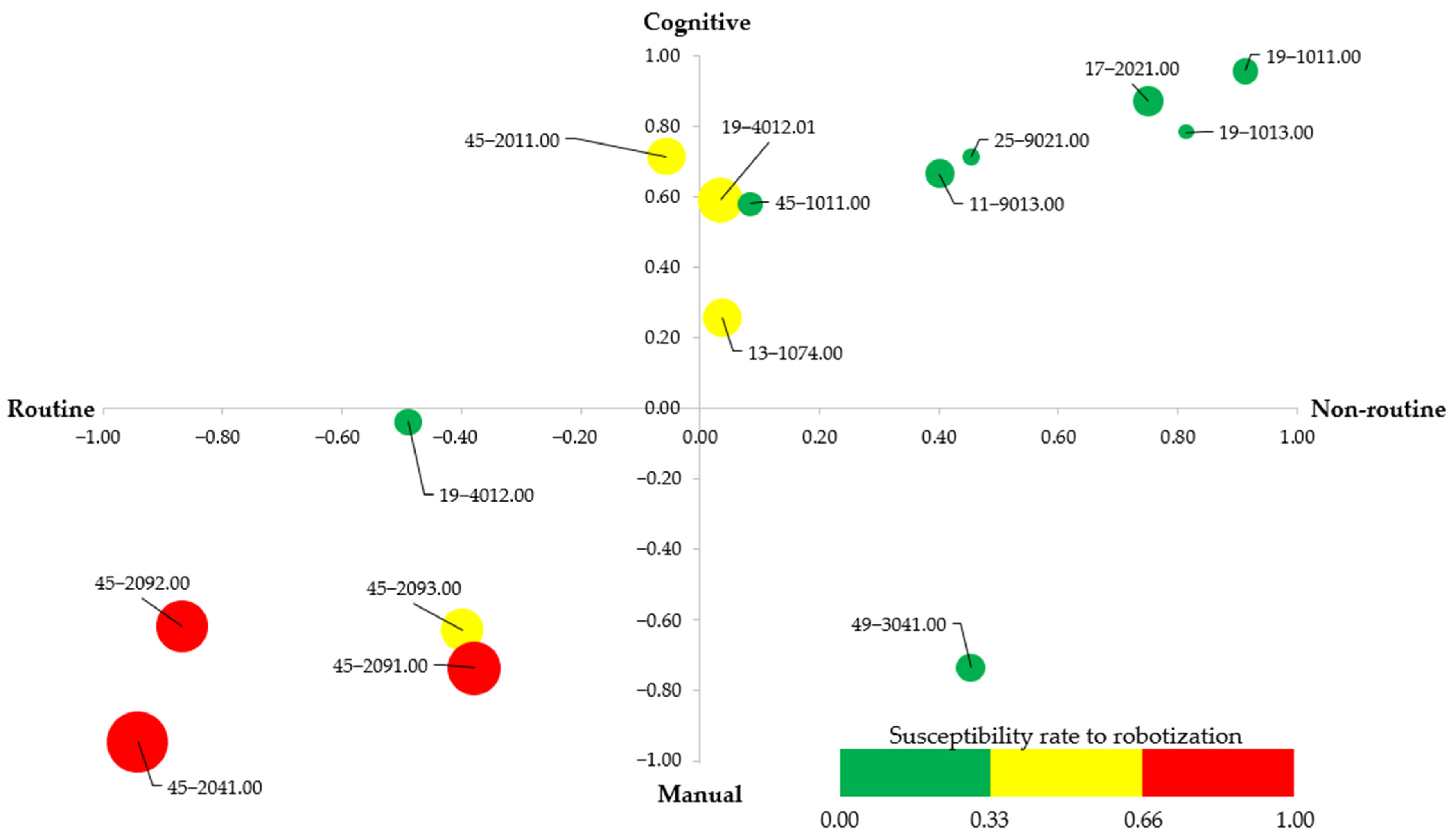
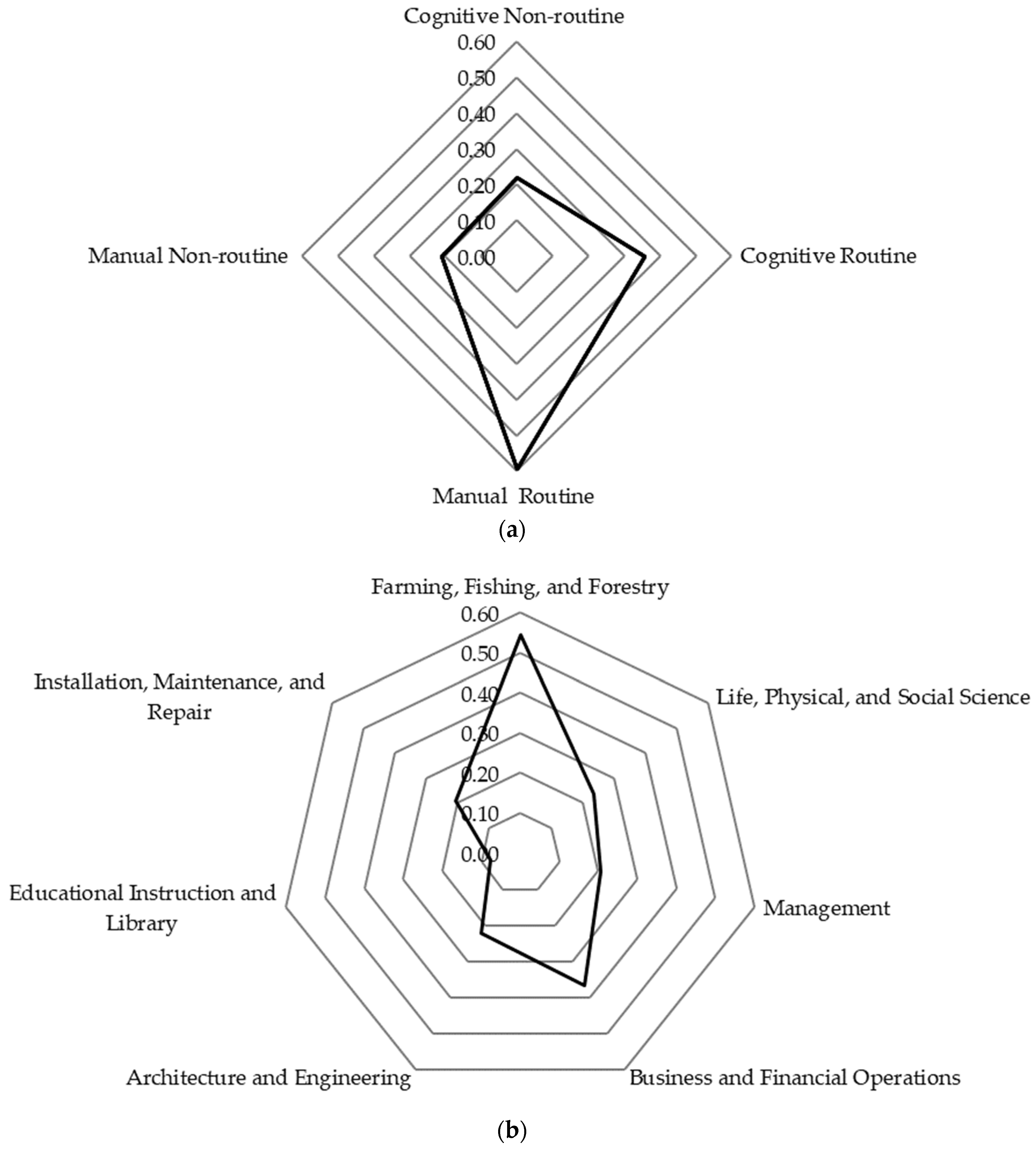
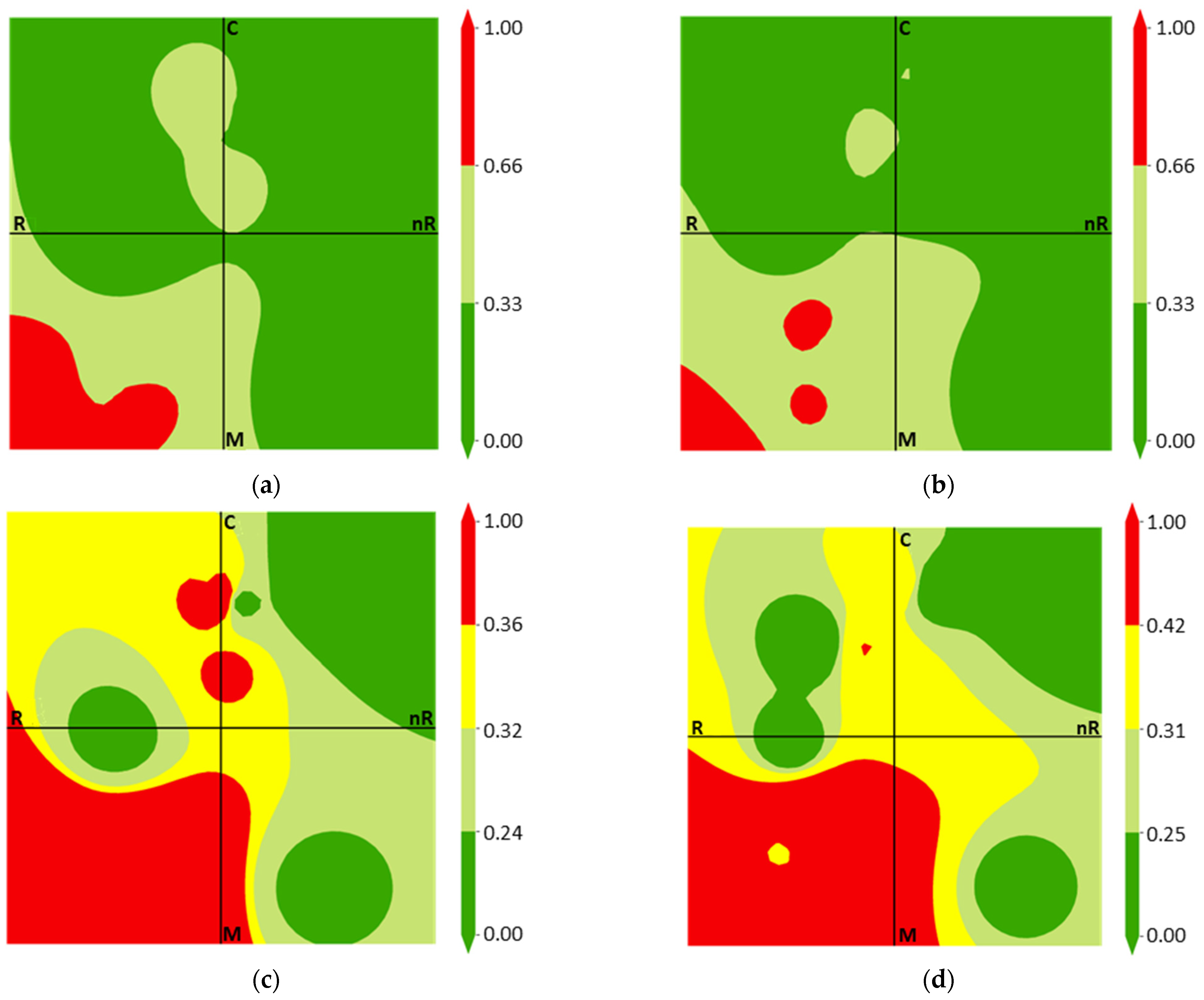
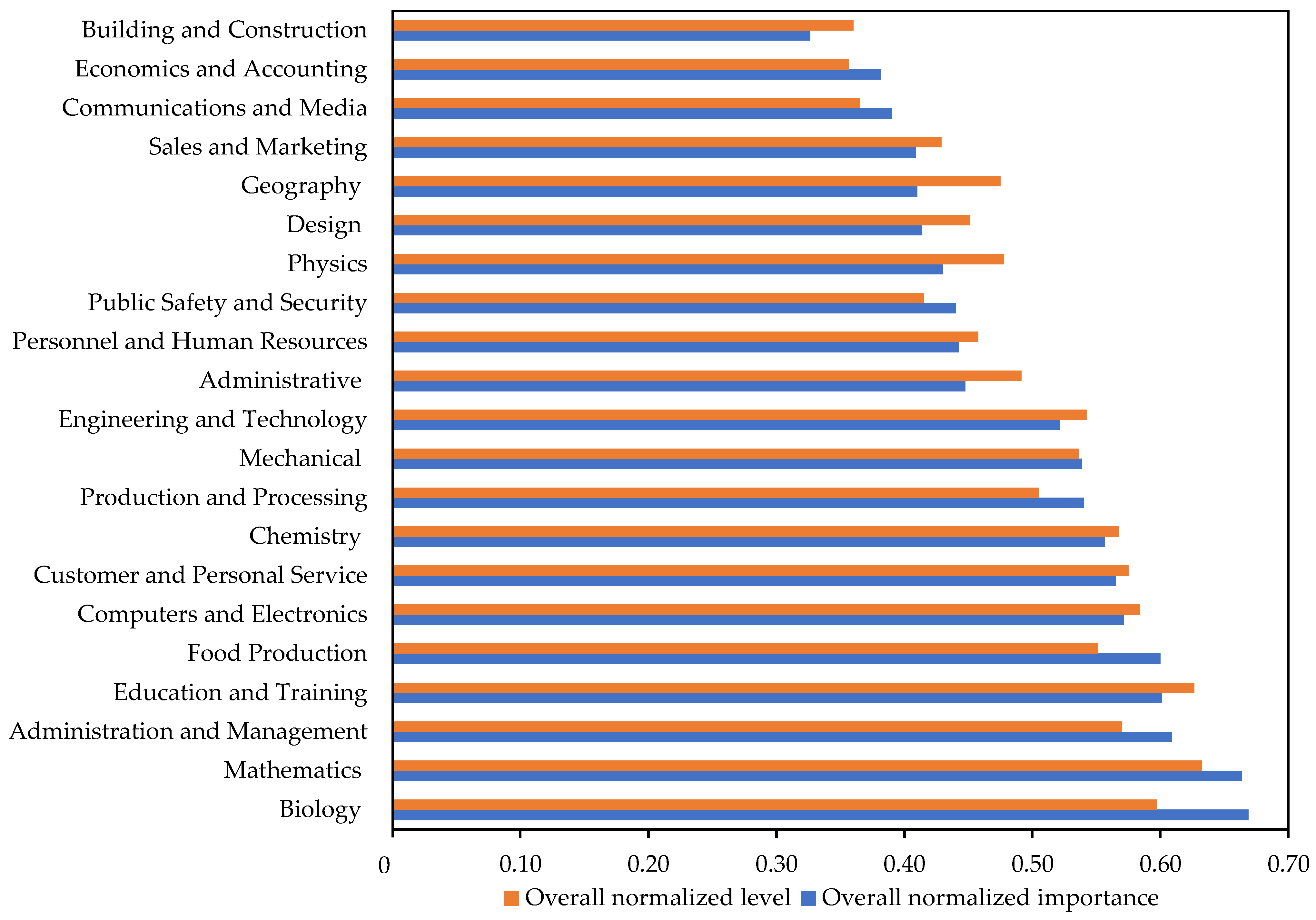
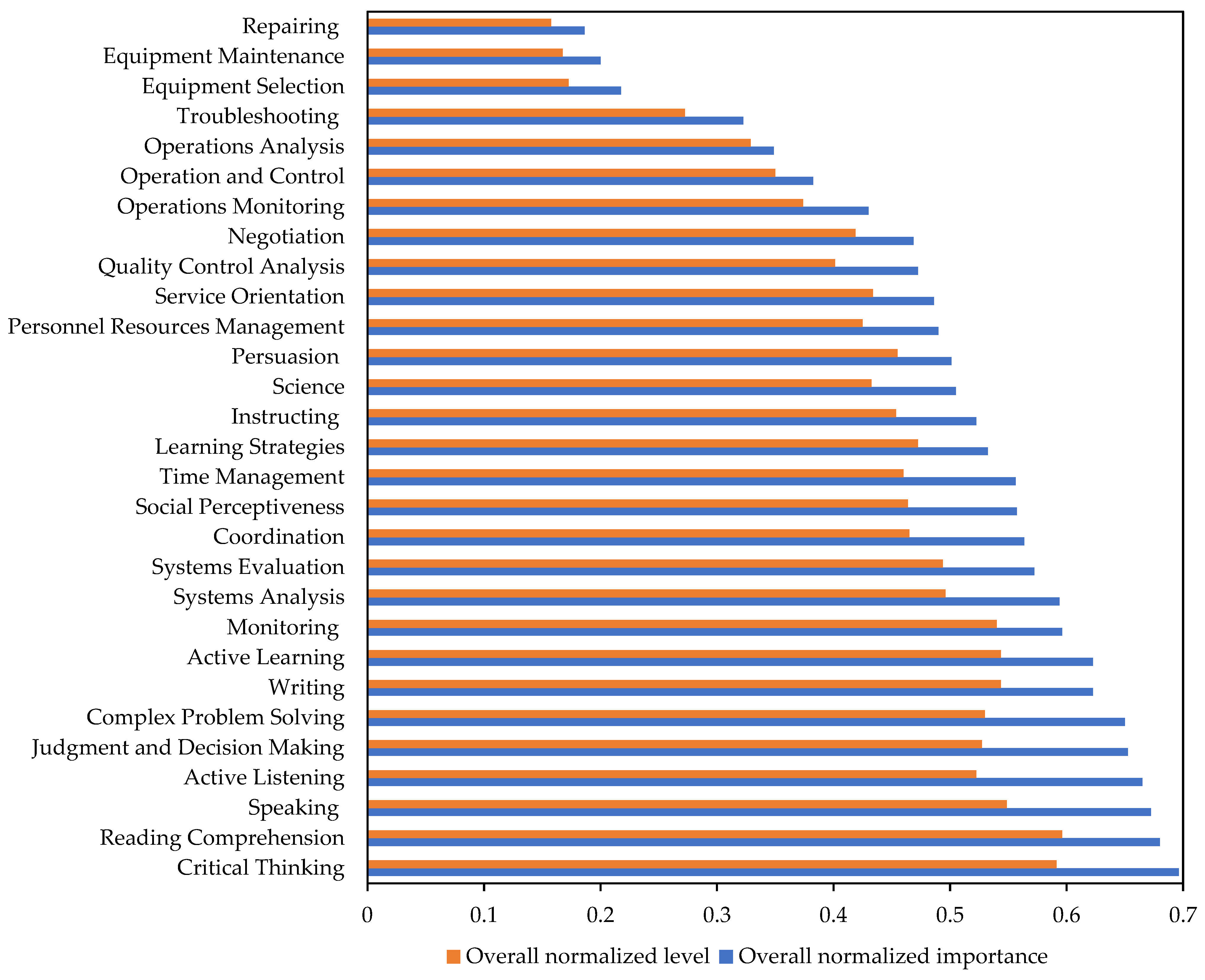

| O*NET-SOC 2019 Title | O*NET Code | Comparison with [29] | Tasks | Knowledge | Skills | Work Styles |
|---|---|---|---|---|---|---|
| Farmers, Ranchers, and Other Agricultural Managers | 11-9013.00 | New code (resulting from the merger of “Nursery and Greenhouse Managers” (11-9013.01) and “Farm and Ranch Managers” (11-9013.02)) | 30 | 13 | 20 | 16 |
| Farm Labor Contractors | 13-1074.00 | Same code; same tasks | 8 | 7 | 8 | 15 |
| Agricultural Engineers | 17-2021.00 | Same code; 1 task added | 14 | 16 | 23 | 15 |
| Animal Scientists | 19-1011.00 | Same code; same tasks | 9 | 10 | 22 | 15 |
| Soil and Plant Scientists | 19-1013.00 | Same code; 7 tasks added | 27 | 12 | 19 | 15 |
| Agricultural Technicians | 19-4012.00 | New code (resulting from “Agricultural Technicians” (19-4011.01)); 1 task added | 26 | 11 | 14 | 16 |
| Precision Agriculture Technicians | 19-4012.01 | New occupation and code | 22 | 13 | 15 | 15 |
| Farm and Home Management Educators | 25-9021.00 | New occupation and code | 15 | 9 | 20 | 16 |
| First-Line Supervisors of Farming, Fishing, and Forestry Workers | 45-1011.00 | New code (resulting from the merger of “First-Line Supervisors of Agricultural Crop and Horticultural Workers” (45-1011.07) and “First-Line Supervisors of Animal Husbandry and Animal Care Workers” (45-1011.08)) | 30 | 9 | 22 | 16 |
| Agricultural Inspectors | 45-2011.00 | Same code; Same tasks | 22 | 7 | 15 | 16 |
| Graders and Sorters, Agricultural Products | 45-2041.00 | Same code; 1 task added | 6 | 3 | 0 * | 8 |
| Agricultural Equipment Operators | 45-2091.00 | Same code; same tasks | 17 | 1 | 7 | 16 |
| Farmworkers and Laborers, Crop, Nursery, and Greenhouse | 45-2092.00 | New code (resulting from the merger of “Agricultural Equipment Operators” (45-2092.01) and “Farmworkers and Laborers, Crop” (45-2092.02)) | 30 | 0 * | 2 | 16 |
| Farmworkers, Farm, Ranch, and Aquacultural Animals | 45-2093.00 | Same code; same tasks | 22 | 7 | 11 | 15 |
| Farm Equipment Mechanics and Service Technicians | 49-3041.00 | Same code; 1 task added | 14 | 8 | 15 | 16 |
| O*NET-SOC 2019 Title | O*NET Code | in [29] | Percentage Change | |
|---|---|---|---|---|
| Farmers, Ranchers, and Other Agricultural Managers | 11-9013.00 | 0.21 | 0.38 | −44.7% |
| Farm Labor Contractors | 13-1074.00 | 0.37 | 0.37 | 0% |
| Agricultural Engineers | 17-2021.00 | 0.22 | 0.23 | −4.3% |
| Animal Scientists | 19-1011.00 | 0.17 | 0.17 | 0% |
| Soil and Plant Scientists | 19-1013.00 | 0.06 | 0.04 | +50% |
| Agricultural Technicians | 19-4012.00 | 0.21 | 0.19 | +10.5% |
| Precision Agriculture Technicians | 19-4012.01 | 0.51 | - | - |
| Farm and Home Management Educators | 25-9021.00 | 0.08 | - | - |
| First-Line Supervisors of Farming, Fishing, and Forestry Workers | 45-1011.00 | 0.15 | 0.17 | −11.8% |
| Agricultural Inspectors | 45-2011.00 | 0.36 | 0.36 | 0% |
| Graders and Sorters, Agricultural Products | 45-2041.00 | 0.92 | 0.95 | −3.2% |
| Agricultural Equipment Operators | 45-2091.00 | 0.71 | 0.71 | 0% |
| Farmworkers and Laborers, Crop, Nursery, and Greenhouse | 45-2092.00 | 0.67 | 0.71 | −5.6% |
| Farmworkers, Farm, Ranch, and Aquacultural Animals | 45-2093.00 | 0.46 | 0.46 | 0% |
| Farm Equipment Mechanics and Service Technicians | 49-3041.00 | 0.21 | 0.23 | −8.7% |
Disclaimer/Publisher’s Note: The statements, opinions and data contained in all publications are solely those of the individual author(s) and contributor(s) and not of MDPI and/or the editor(s). MDPI and/or the editor(s) disclaim responsibility for any injury to people or property resulting from any ideas, methods, instructions or products referred to in the content. |
© 2024 by the authors. Licensee MDPI, Basel, Switzerland. This article is an open access article distributed under the terms and conditions of the Creative Commons Attribution (CC BY) license (https://creativecommons.org/licenses/by/4.0/).
Share and Cite
Marinoudi, V.; Benos, L.; Camacho Villa, C.; Lampridi, M.; Kateris, D.; Berruto, R.; Pearson, S.; Sørensen, C.G.; Bochtis, D. Adapting to the Agricultural Labor Market Shaped by Robotization. Sustainability 2024, 16, 7061. https://doi.org/10.3390/su16167061
Marinoudi V, Benos L, Camacho Villa C, Lampridi M, Kateris D, Berruto R, Pearson S, Sørensen CG, Bochtis D. Adapting to the Agricultural Labor Market Shaped by Robotization. Sustainability. 2024; 16(16):7061. https://doi.org/10.3390/su16167061
Chicago/Turabian StyleMarinoudi, Vasso, Lefteris Benos, Carolina Camacho Villa, Maria Lampridi, Dimitrios Kateris, Remigio Berruto, Simon Pearson, Claus Grøn Sørensen, and Dionysis Bochtis. 2024. "Adapting to the Agricultural Labor Market Shaped by Robotization" Sustainability 16, no. 16: 7061. https://doi.org/10.3390/su16167061
APA StyleMarinoudi, V., Benos, L., Camacho Villa, C., Lampridi, M., Kateris, D., Berruto, R., Pearson, S., Sørensen, C. G., & Bochtis, D. (2024). Adapting to the Agricultural Labor Market Shaped by Robotization. Sustainability, 16(16), 7061. https://doi.org/10.3390/su16167061













